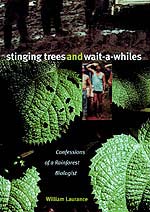"If you really think that conducting biological research in the tropics is a glamorous occupation, then here's a reality check. . . . A lucid, highly readable report on ecological science on the front lines."—Kirkus Reviews
"Just the sort of fly-on-the-field-hut-wall view of life as a tropical ecologist that we want. . . . The biology is splendid. . . . At the time Laurance carried out his study, Queensland's rainforests were on the brink of receiving World Heritage status, and this brought conservation up against hard politics. Stinging Trees shows the courage it demanded to be a 'greeny' in a Queensland logging town. No less importantly, it documents the ecology-shattering effects of forest fragmentation."—Adrian Barnett, New Scientist
"Impassioned and accessible to a range of audiences, this is a laugh-out-loud, engaging account of the antics of a clever, impetuous Yank 'gone troppo' in the Australian outback."—Publishers Weekly
"Through a series of vividly written vignettes chronicling his 18 months of field study in the Australian rain forest during the mid-1980s, biologist Laurance recreates his wild and frequently harrowing experiences with the native flora and fauna as well as his role in the political debate over rain forest destruction. . . . The travelog and adventure-story aspects of this book will appeal to a wide audience, while the ecological aspects will appeal to scientists and rain forest enthusiasts."—Library Journal
Some related websites:
Wet Tropics Management Authority:
all about the Wet Tropics World Heritage Area
Wet Tropics of Queensland World Heritage Site:
a detailed description from the World Conservation Monitoring Centre
The Tropical Tableland Promotion Bureau:
a tourist bureau site for the Atherton Tableland
Rainforest-Australia:
an information site maintained by Chambers Wildlife Rainforest Lodge in Atherton Tableland
Forest Conservation Archives & Portal:
a source for forest, rainforest, and biodiversity conservation news and information
Rainforest Action Network:
an advocacy and action organization
Native Forest Network:
a collective of activists and organizations
Conservation International:
an organization for preserving biodiversity
Stinging Trees and
Wait-a-Whiles:
Confessions of a Rainforest Biologist
William Laurance
The alarm buzzed at 1 A.M. Half awake, I made a cup of coffee and forced down a few quick gulps before dialing a long series of numbers. After several rings the phone was answered by a secretary with a breezy California accent. I was making my monthly call to Bill Lidicker, my major professor.
It was 9 A.M. in Berkeley and Bill answered in his usual concise way. In his earlier days he'd been a veritable boy genius, completing his Ph.D. at the University of Illinois by the age of twenty-four. He immediately accepted a faculty position at UC Berkeley where one of his first graduate students, George Heinsohn, was older than he was.
Now in his early fifties, Bill had spent nearly three decades at Berkeley. By coincidence, after finishing his doctorate, George Heinsohn moved to Australia where he took a faculty position at James Cook University in north Queensland. When I first visited the region for a few months in 1984, George persuaded the equipment manager at the university to lend me a brand-new pickup and thousands of dollars' worth of mammal traps, spotlights, and camping equipment. I hadn't met George before then, but because of the Lidicker connection we felt like academic brethren.
As a major professor, Bill was pretty sparing with his advice—something I liked—but when he did offer suggestions they were usually excellent ideas. He was also a quick and critical thinker, so I tried to be on my toes when I phoned him.
 Some rainforest trees, like this stately giant, may be over 1,400 years old. Photo by Author. | |
We spent several minutes reviewing the project, and I reported that the fieldwork was going surprisingly well thanks to the efforts of our volunteers. I sketched recent events but left out a few minor details such as food fights, romantic dramas, and our latest run-ins with the Millaa cop. I also explained that rainforest conservation issues were really heating up. Australia's federal government was being pressured to declare the rainforests of north Queensland a World Heritage Area. If this happened it was almost certain that rainforest logging in the region would be stopped.
Over the years many people have asked me, Why Australia? Why go Down Under to study rainforest fragmentation when there are so many degraded landscapes to choose from in South or Central America? There are two answers to that question—one short and one long. The short answer is Bill Lidicker. The long answer is, well, long.
Even before I'd arrived at Berkeley as a rookie graduate student, I'd decided I wanted to study how the fragmentation of rainforests affects the animals that live within them. This quest had evolved for several reasons: it was a massively relevant issue from a conservation perspective; it was exotic and challenging; and I'd developed an interest in tropical fauna while working summers in zoos and wild animal parks in the United States and England. I had not, however, decided what kinds of animals I wanted to study or where I'd go to study them.
I initially thought birds would be a good group to work with, but Bill—a dyed-in-the-wool mammalogist—made it clear that while I was free to study birds, if I did so his interest in my project would be substantially reduced. I wasn't a complete idiot. On that day I made a career-changing decision: I became a mammalogist too—a decision, I must say, I've never regretted.
This left the question of where I would conduct my fieldwork. Latin America was the obvious choice but there was one small problem—my language skills. Like so many Americans I was raised to be appallingly monolingual. I'd picked up some rudimentary Spanish while traveling in Mexico, but I was having a hard time imagining myself setting up a complex field project in a remote area while trying to ask the locals how to buy ten-amp fuses or mammal bait using wild gesticulations and a hundred-word vocabulary. The prospect did not seem promising.
It was for this reason, perhaps, that Bill's suggestion of a visit to north Queensland fell on receptive ears. Up to that point I hadn't even realized that there was rainforest in Australia. The local residents even spoke English, sort of. The clincher was that Bill had himself studied in Australia years ago and was keen to get a student working there now, trying to maintain a vicarious involvement with the unique Australian mammals. He was positive there had been a lot of logging and forest clearing in north Queensland, and offered to put me in touch with some Australian colleagues like George Heinsohn who might be able to help me find a forest to study.
 Tropical Queensland, in the vicinity of Cairns and the rural towns of the Atherton Tableland. Dark-gray areas are rainforest, while light-gray areas are deforested, or support dry forests. The Atherton Tableland stretches from Ravenshoe northward to Atherton and beyond. | |
I wrote letters to a half dozen people and virtually everyone said the same thing: the Atherton Tableland was the ideal place to study rainforest fragmentation. Not only was the area of extreme biological importance, but many of the fragments had been isolated over half a century earlier. This was a key feature. The process of biological decay takes time. Populations wither and die slowly, and can take decades or longer to disappear completely. In much of the developing world it is hard to find fragments more than ten or twenty years old, because in most areas large-scale deforestation has occurred only recently. But the fragments of the Atherton Tableland were old enough for many consequences of fragmentation to become manifest. Like a looking glass into the future, these remnants might provide insights into the eventual fate of degraded rainforests elsewhere in the world.
I finished my report to Bill and jotted down several suggestions he'd made. As I hung up, I thought about him sitting in his office. A voracious reader, each month he received dozens of journals and wildlife magazines, which over the years had grown into massive stacks that towered like lopsided skyscrapers from every horizontal surface in his office. I used to tease Bill that when the inevitable big earthquake finally hit the Bay Area, they'd never find his body beneath his thousands of books and journals.
Following the departure of Dale, Cathy, and the others we needed some fresh volunteers to bring us back up to full strength. I drove down to Cairns to pick up the latest recruits: Will, a lively eighteen-year-old from Boston; Mike, a suave Canadian; and two Brits, Bridgette and Martin.
During the drive home Bridgette and Martin sat in the back while I chatted up front with Will and Mike. Will was enthusiastic and wide-eyed at the thought of working in the rainforest. I gave him and Mike the usual spiel, explaining what we were doing and trying to impress upon them the serious nature of our work. The tale of our wild food fight had spread like a cyclone through Millaa Millaa, and since then I'd been making a concerted effort to inject some sobriety into our operation.
As we wound up the steep mountain road we passed some road construction, and I had to shift to the opposite lane for a few hundred yards. I was a little tired and, after clearing the construction, simply forgot to move back to the other side of the road. Chatting away amiably, none of us three North Americans noticed that we were driving on the right-hand side—the wrong side Down Under. I was in the midst of explaining to Will and Jeff how important it was for us to have a professional field operation when a huge freight truck suddenly came roaring around a corner straight at us.
We all screamed. I jerked the wheel to the left while the trucker slammed on his brakes and veered right. Our tires screeched shrilly and we slid out of control toward the road verge, which dropped off almost vertically for several hundred feet. The pickup tight-roped the precipice between the road and oblivion, finally lurching to a stop only inches from the edge. The trucker, stopped fifty yards away, fired angry blasts at us on his air-horn.
Martin and Bridgette were picking themselves up off the floor of the pickup. Mike had opened the door and crawled out onto the ground, looking like he was about to bestow a papal kiss to the gravel beneath him. Will's eyes were bulging fearfully as he stared at me. I could see him thinking, You call this a professional operation??
I gulped deep breaths and apologized profusely to everyone. We sort of laughed it off, but as we drove on, I could sense an edge of nervousness in my companions that hadn't been there before.
Will, I discovered, had a cheeky sense of humor. The next day he handed me a little gift: a plastic keychain with a label for the driver's name, which he'd found at the general store in Millaa. In lieu of my name he'd written three words of advice: "THINK—DRIVE LEFT!"
In many ways Will was unique. I can honestly say, for example, that I've never met anyone since who carried a typewriter in his backpack. But Will, an aspiring author, did so, and clacked out long passages and letters to friends with impressive regularity. He possessed that sense of awe and magic that takes hold of some people, driving them beyond the normal limits of human endeavor. At times, manically energized by some recent discovery, mere words failed him. "The rainforest, Bill . . . It's just so, so . . . so Aaaaaahhhhh!"
I nodded. I thought I knew what he meant.
I also came close to murdering Will a few times, and so did the other members of our crew. Although we really liked the guy, he never seemed to stop arguing. It didn't matter what the subject was—politics, biology, personal grooming habits—Will loved to take a contrary tack. If you thought the 49ers were going to win the Super Bowl this year, Will would give you five cogent reasons why they couldn't. Thinking about investing in the stock market? He'd be happy to talk you out of it, illustrating his arguments with frightening true stories of small investors who'd lost every penny in some market crash. He had a mind like a steel trap, and a mouth like Howard Cosell.
 A Day-Glo rat. Covered in fluorescent dye, this bush rat left a bright trail that allowed us to track its nightly activities. Photo by Author. | |
Will was the only person who ever argued with me about setting traps. We'd developed a ritual of walking every trapline at the beginning of each five-day session to inspect all the traps that had been laid out and baited. Setting traps is actually quite tricky. The trap needs to be stable and set properly. Because most mammals exhibit wall-hugging behavior—they like to run alongside logs and other objects—it's important to position the trap at the base of a tree or beneath a log or clump of vines. Ideally, there also should be some cover over the trap, like a shrub, so the animals don't feel exposed to owls, their main predators.
So I'd walk down each line and ask someone to shift this trap a few feet, or double-check that trap to make sure it worked properly. No one ever minded—until Will came along. Then even a simple request became a major drama. If I asked Will to move a trap under a nearby log, he'd launch into a long-winded explanation about why his trap placement was flawless as it was. He'd go so far as to crouch down on his hands and knees to illustrate just what the mammal would be seeing and thinking as it approached his trap. If I insisted, Will would get his back up and stubbornly refuse to budge. He was sure he was right and wasn't going to move the damned trap just because it was my project and I was telling him to do so.
Caught off guard by Will's defiance, on several occasions I found pleasant homicidal images flitting through my mind. What was I going to do with this guy?
I finally hit upon the answer: wrestling. It was the perfect solution. When I felt like killing Will I simply took him down and crunched him into a pretzel. Although Will considered himself a fair wrestler, not only was I bigger than him, but I'd wrestled in high school and college. This afforded us a number of opportunities to examine Will's attitude problem. I'd rack Will with a double arm-bar, then inquire as to whether he might reconsider moving the trap we'd just spent ten minutes arguing about. Or I'd torque him with the "guillotine"—my personal favorite—and ask if he wished to rethink all the insensitive things he'd said the previous evening about the San Francisco 49ers.
In wrestling, at least, Will lost his argumentative nature. He was too busy screaming and begging to be let go.
We were soon joined by another volunteer, Jeff, a rotund, bearded Canadian, who brought our crew up to ten. Although we really didn't need an additional person, Jeff had his own jeep, which I coveted.
Like Will, Jeff turned out to be a character. Though lacking scientific training, he was the most enthusiastic advocate of evolution I've ever met. To him, Stephen Jay Gould attained almost deity status. Jeff would propound at great length about evolutionary phenomena or bitterly castigate the fundamentalists who opposed teaching evolution in schools. He was fond of quoting Gould at length, having memorized his writings like some Confucian tome. He had a derisive attitude toward most people but liked me because I knew enough about evolution to be worth talking to.
For some reason, Bridgette began to seriously dislike Jeff. She described him as "creepy" and "weird." This was an overreaction, I felt, but nevertheless I wasn't pleased about this obvious discord among the troops. Will continued to drive us all crazy, as usual, but then we hit upon a solution that made everyone happy. Will and Jeff could work together—in isolation from the rest of us.
It was an ideal plan. Jeff had his own vehicle and we were just starting a new kind of trapping strategy, using extra cage traps I'd borrowed from the Tropical Forest Research Centre in Atherton. Instead of baiting these traps with our usual oats and vanilla, we would use beef or chicken. With these new traps we were hoping to catch predators—especially the spotted-tailed quoll, an almost mythical beast which had so far eluded us. A much-bigger relative of the ferocious antechinus, the quoll was the size of a big raccoon, all teeth and fury. It was the largest marsupial predator in the region—at least since the thylacine, or marsupial wolf, had been driven extinct.
 The Rat Patrol, ready for action. Pictured are Sally Beatty, Steve Comport, John Vollmar, myself, and Will Chaffee. Photo by a bystander. | |
After a short training session, Will and Jeff headed off with the predator traps. The rest of us worked harmoniously doing our usual trapping and spotlighting. While I initially had reservations about turning Will and Jeff loose unsupervised, they did a fine job, and took great pride in their work. Jeff, in fact, liked to brag that they were "The Higher-Mammal Crew"—a reference to their working with glamorous predators—while the rest of us were merely "The Rat Patrol." That was fine with us. Will and Jeff were easy to take in measured doses—just not twenty-four hours a day.
It was now early October and the Austral summer was fast approaching. With the warmer weather we began to encounter more snakes, which were entering their breeding season. This was the time that most people got bitten, when the snakes became aggressive and almost oblivious at times to people hiking in the forest. There had just been a horrible incident in Innisfail, a coastal city to the east of us. A toddler had been killed by a taipan while playing in his own backyard. He'd been bitten over a hundred times.
One morning we came almost face to face with a big red-bellied blacksnake—a good six feet long—which had reared up like a cobra upon hearing us approach. We paused and gave it plenty of room until it continued on its way, but it reminded us that we needed to stay alert.
Our next encounter was a little more scary. We were checking our traps one morning, numbed by the early hour. We were working in a hundred-acre fragment that, like many others, had been battered by the recent cyclone. Fallen trees, wait-a-whiles, and debris littered the ground. I reached down to pick up a cage trap that had been tripped, but couldn't see the trap well because it was obscured by debris. My hands were maybe six inches from the trap when a jet-black head shot out and struck at my hand, sending me flying backward. Everyone jumped as I hollered. A red-bellied blacksnake had gotten itself caught in the cage trap and was frantically trying to get out. It kept jabbing its head and neck out of the inch-square mesh but couldn't squeeze the rest of its body through the holes.
It took us quite a while to figure out how to let the snake go without getting bitten. We thought about killing it—it obviously lived right in the middle of our trapping grid—but decided that wasn't the right thing to do. We finally managed to release it with two long sticks, unlatching the trap door and holding it open long enough for the snake to spring to freedom and disappear into the undergrowth. We were all pretty jumpy after that—and completely wide-awake.
The worst snake encounter happened one night while I was out spotlighting. I was hiking along a trail that bisected a fifty-acre fragment. As was often the case, I was alone, and hadn't even brought Tully along. I'd just seen a female tree-kangaroo and her very cute joey foraging down on the ground, and was filled with warm fuzzy feelings about the rainforest and its amazing wildlife.
The trail I was hiking along was steep. I came to an eroding bank that dropped off for four feet. I grabbed hold of my backpack to keep the heavy battery from slamming into my back, then jumped off the bank, landing in soft dirt. Something squirmed and struck at my feet. I must have set some sort of world vertical-leap record—I'm not sure how high I went but I landed at least four feet away. I'd pivoted 180 degrees in mid-air and was now facing back toward the bank, shining my light where my feet had landed.
There in my spotlight, partly compressed into the dirt, were two extremely angry red-bellied blacksnakes. They'd been—in the professional lingo of biologists—doing it, when I'd had the extremely bad manners to fall out of the sky and land on them. They were now going completely crazy, thrashing and hissing and striking frenetically while they tried unsuccessfully to get away, their bodies firmly stuck together by the male's hemipenis.
I backed away quickly, my whole body shaking. A few moments later I stepped on a fallen branch and nearly leapt out of my skin again. Now calm down, I told myself, don't do a Joachim out here. I took deep breaths and eventually my heart stopped beating so wildly.
Finally I calmed down enough to resume spotlighting. In a way I felt rather sorry for the two blacksnakes. Here they are, enjoying a romantic evening—the moon is full, the night is warm—when suddenly this two-hundred-pound gorilla comes leaping out of the night and drowns them in the dirt. Talk about coitus interruptus.
Copyright notice: Excerpted from pages 81-88 of Stinging Trees and Wait-a-Whiles: Confessions of a Rainforest Biologist by William Laurance, published by the University of Chicago Press. ©2000 by the University of Chicago. All rights reserved. This text may be used and shared in accordance with the fair-use provisions of U.S. copyright law, and it may be archived and redistributed in electronic form, provided that this entire notice, including copyright information, is carried and provided that the University of Chicago Press is notified and no fee is charged for access. Archiving, redistribution, or republication of this text on other terms, in any medium, requires the consent of the University of Chicago Press.
William Laurance
Stinging Trees and Wait-a-Whiles: Confessions of a Rainforest Biologist
Cloth $25.00 ISBN: 0-226-46896-8
©2000, 214 pages, 16 color plates, 40 halftones, 4 maps
For information on purchasing the book—from bookstores or here online—please go to the webpage for Stinging Trees and Wait-a-Whiles.
See also:
- Our catalog of Biology titles
- More excerpts from books about the tropics:
- Other excerpts and online essays from University of Chicago Press titles
